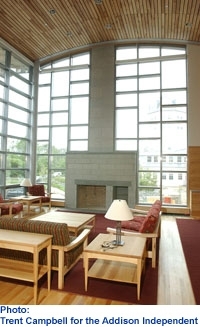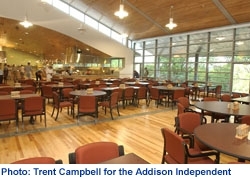September 11, 2002
Contact:
Sarah Ray
802-443-5794
sray@middlebury.edu
Posted: September 11, 2002
MIDDLEBURY, VT At
a dedication ceremony on Friday, Sept. 13, Middlebury College will celebrate
the construction of a new dining hall and dormitory-the first phase of
a restructured residential life system. The opening of Ross Dining, a
new 275-seat facility, and LaForce Hall, a new 67-bed student residence,
marks the completion of Ross Commons.

Located
on the western edge of the campus, the new buildings are part of the College’s
effort to create small communities, or commons, where living, dining and
learning all take place in the same area in an environment that encourages
a melding of academics and social life. Ross Commons is the first of five
commons to be completed, and also includes four pre-existing dormitories
now connected to the new buildings by an enclosed walkway.
Construction on the
new facilities began in September 2000. Tai Soo Kim Partners of Hartford,
Conn., designed the buildings and New York City-based Barr & Barr,
which has an office in Middlebury, constructed the $19.5 million project.
LaForce Hall was designed
to provide senior students with high quality housing. Four-bedroom suites
include kitchen and bathroom facilities. Eleven single rooms on the fifth
and highest floor share a communal kitchen and lounge. The building’s
other features include additional social space; offices for faculty, the
Ross Commons dean and other commons staff; a classroom and a study space.
All rooms in the building are connected to the campus computer network.
The new dining hall has high ceilings and one of its walls, consisting
largely of windows, faces New York’s Adirondack Mountains. Four stations
offer diners options ranging from pizza and deli items to food cooked
on a Mongolian grill.
Tom McGinn, Middlebury College project manager, said, “Wherever possible,
we used local products and drew on the talents of the Vermont labor force.”
The
College made these efforts as a partner in the Cornerstone Project, an
initiative coordinated by the nonprofit Vermont Sustainable Jobs Fund
that encourages Vermont institutions to purchase Vermont goods and services.
The
College also used 32,500 feet of “certified” wood for the project.
Sixty percent of this wood was harvested from College forests on its Bread
Loaf campus in Ripton. Certified wood must meet standards that conform
to sustainable forest management practices. In the case of Ross Commons,
the international environmental organization Forest Stewardship Council
(FSC) supplied the criteria for harvesting the wood, which was used throughout
the project for all wood floors, ceilings, paneling and trim.

Work
will begin this week on the next phase-the construction of two dormitories
and a dining hall for Atwater Commons-and is scheduled for completion
in 2004.
College officials said the impetus for restructuring residential life
at Middlebury comes from the desire to broaden and enrich the residential
college experience. “There are some who argue that the knowledge
that professors convey to students in the classroom and the laboratory
can be delivered to students using the Internet and the World Wide Web,”
said Middlebury College President John M. McCardell, Jr. “One way
residential colleges can combat the charge that technology can essentially
replace us, while at the same time developing a more comprehensive learning
environment, is by making certain that what takes place
outside the classroom in the residential facilities makes a substantial
contribution to the educational experience of our students,” he said.
According to McCardell, “The completion of Ross Commons provides
the first physical space on campus designed specifically to encourage
this kind of exchange.”
“We’d
like to see the new spaces in Ross, including the dining hall, become
places for spontaneous student expression. On a random afternoon you might
hear music being made in the lounges, or have your meal interrupted by
a short one-act play. Anything goes as far as we are concerned,”
said Steve Abbott, associate professor of mathematics. He and his wife
Katherine Smith Abbott, visiting assistant professor of art history, are
also co-faculty heads of Ross Commons.
The
Commons System
The
commons, a residential life system, first developed at Middlebury in the
early 1990s, but it was not until 1998, with the trustees’ vote of approval,
that the College embarked on construction projects that ultimately will
define each commons physically as a distinct community with its own dining
facilities.
Each residential cluster, or commons, houses 400-500 students. Middlebury
students are assigned membership to one of the five commons upon enrollment
at the College.
Every
commons is led by a team-a faculty head, a dean, a commons coordinator
and two commons residential advisers-who counsels and supports student
residents and guides the cultural and intellectual life of the community.
The commons system is based on three governing principles: continuing
student membership, decentralized dining and proximate faculty residence.
The principle of continuing membership in a commons, according to College
officials, is intended to provide a more stable, cohesive community atmosphere
in the residential facilities. McCardell compared the experience of living
in residential commons to living in neighborhoods. He believes that the
old system, in which most students live in a different room or dorm each
year and which would be considered jarring and disorienting outside the
college setting, inhibits the formation of close and lasting friendships
among students.
Decentralized dining, the second principle, will extend the opportunities
for intimate contact among students and with faculty and staff. “Smaller
dining spaces encourage people to linger after meals for conversation,”
said McCardell. “Conversation opens doors to informal learning and
enriching interaction, which is entirely different from the learning that
occurs in the classroom,” he said. “We are looking forward to
seeing this vision fully realized in the new dining hall in Ross Commons.”
The
third principle, proximate faculty residence, adds yet another dimension
to the enhanced educational setting. The faculty members designated as
commons heads live with their families in College-built houses located
near each student commons residence.
“The
raw material of students’ education-the books, the lists of theorems-isn’t
really going to change much from place to place. What makes Middlebury
different is what we do with each other. The attraction of the commons
system to myself and my wife Katy is that it takes direct
aim at this principle by fostering new and innovative ways to live and
learn together. And the reason it works is that it puts a great deal of
the responsibility for making this happen in the hands of the students,”
said Abbott. McCardell believes, “Institutions that claim as their
mission to educate young men and women in the tradition of the liberal
arts must define education broadly and acknowledge that education takes
place around the clock and in all venues. The commons supports this mission.”

